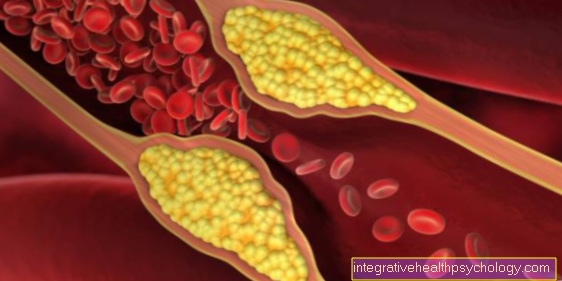The scarlet tongue
What is a scarlet tongue?
The tongue takes on a characteristic color when scarlet fever is present. After it is initially covered with white deposits, it appears red and shiny after these deposits have subsided. In addition, it looks like the scarlet tongue has lots of small pimples. These are the taste buds that stick out due to the infection.
The scarlet tongue is also called because of its characteristic color Raspberry or strawberry tongue. It can easily be confused with the raspberry tongue, which occurs in Kawasaki syndrome (a disease of the lymph nodes).

Cause of a scarlet tongue
The cause of the scarlet tongue lies in the infection with the scarlet fever pathogen. The type of bacteria is to blame Streptococci. These bacteria tend to settle in the throat, throat and mouth area. There they lead to a strong inflammatory reaction, which is why the throat and throat are painfully red. Inflammation also occurs in the tongue. The tongue consists almost entirely of muscles, on which is the mucous membrane with its taste buds.
If the tongue is now inflamed, it swells a little and, as with any inflammation, pain and redness occur. Overheating of the tongue is also possible. However, this is often not noticeable in the context of the high fever in scarlet fever. The swelling of the tongue also pushes the taste buds slightly outwards, which is why they appear so noticeable. Most of the time, the pathogens are also on the taste buds themselves. These also swell and become even more prominent.
The scarlet tongue is also known as the raspberry or strawberry tongue. This is due to their sometimes deep red color and the protruding taste buds, which are reminiscent of a fruit.
Other possible causes of raspberry tongue can include:
- measles
- a pellagra (too few vitamins in case of malnutrition)
- the Kawasaki syndrome (a lymph node disease)
What does the scarlet tongue look like in the early stages?
The typical scarlet tongue with its protruding taste buds and the deep red color usually only appears after a few days.
Before that, the tongue is covered with a thick white coating. These spotty white deposits also appear in the throat and on the tonsils. Even before the tongue loses its coating and takes on the shiny red tone, the taste buds can swell, which means that they stand out somewhat from the surface of the tongue. This makes the tongue look very rough, and the white deposits stick to the uneven surface more strongly.
An inflammatory reaction can also take place in the tongue itself due to the infection. This causes the tongue to swell. It can also cause severe pain. The red color of the tongue is also due to this inflammatory reaction, but it is not yet visible in the early stages of the disease due to the coatings.
You may also be interested in this topic: Tonsillitis
Concomitant symptoms
With scarlet fever, in addition to the typical raspberry tongue, other symptoms also occur in the throat and throat area. This includes a very red and painful throat, the tonsils can swell. In addition, whitish deposits often develop, which not only affect the tongue but also the tonsils and throat. Concomitant symptoms include a strong fever and even chills, and headaches and abdominal pain can also occur. The swelling of the tongue and the pain in the tongue, throat and throat make swallowing difficult.
The lymph nodes may also swell as a sign of severe infection. These form guard stations in the lymphatic system and are an important part of the body's immune system. The lymph nodes on the neck and under the chin in particular swell with scarlet fever. But lymph node swellings can also develop in other places such as the armpit and under the collarbone.
After about four days, another characteristic symptom of scarlet fever appears: the rash that arises from many small red spots. These are usually slightly raised so that they can also be felt as small bumps on the skin. Typically the mouth is spared from this rash, this is also called "perioral paleness', also colloquially milk beard. After about two weeks, the skin begins to peel off on the fingers and toes. Sometimes the entire soles of the feet and palms are also affected.
Find out more about the topic here:
- Symptoms of Scarlet Fever
- Scarlet fever rash
Concomitant symptom: Burning tongue
Because of the inflammation that also occurs in the tongue in scarlet fever, it is particularly sensitive.
Inflammatory reactions cause nerve endings that transmit information such as pain and burning to the brain to respond more quickly to touch. This is triggered by certain substances that are released from the body when there is inflammation. This is why the tongue is particularly sensitive to infections such as scarlet fever and reacts to contact as well as heat and cold with pain and burning.
The swelling of the tongue and taste buds also causes the taste buds to protrude slightly from the tongue. This makes them even more sensitive to touch and increases the burning of the tongue.
Read more about this: Burning tongue
Concomitant symptom: pain
The pain associated with scarlet fever is due to the body's strong inflammatory response. The tongue, throat, and throat become severely swollen and red during the infection. This makes them particularly sensitive to touch and strong temperature changes such as heat and cold.
With scarlet fever, pain also often occurs in the joints (polyarthritis) or as muscle pain in the context of high fever. Headache and stomach ache can also be associated with scarlet fever. As a rule, they are also due to the fever, and often also to insufficient drinking.
You may also be interested in this topic: Pain in the tongue
Treatment of scarlet fever
Treatment of scarlet fever should definitely be done with antibiotics. These can effectively fight the triggering bacteria and thus protect those affected from serious complications such as heart, kidney and liver diseases as well as abnormalities in the brain. Typically, penicillin V is used as the antibiotic of choice. If you are allergic to penicillin, you can also use erythromycin or clarythromycin can be used.
More information is available here: Treatment of scarlet fever
In addition to the causal therapy with antibiotics, symptomatic treatment should also be given, especially in the case of high fever attacks. This includes the administration of antipyretic agents, and pain should also be relieved with pain medication. If this is not enough to curb swallowing difficulties and sore throats, lozenges, which are otherwise used for colds, can help.
Also home remedies such as sage or ginger tea with honey are helpful because they have antibacterial ingredients, have a calming effect on the chipped mucous membranes in the throat and at the same time ensure adequate hydration.
If the fever is particularly high, cool calf compresses or quark compresses can also be used, which lower the body temperature subtly.
Learn more about: Calf wrap against fever
Since scarlet fever is a serious infectious disease, affected people should take some physical rest for a few days. There is also a high risk of infection, which is why relatives and other contact persons must be adequately protected.
Diagnosis of scarlet fever
The diagnosis of scarlet fever is usually obvious based on the typical symptoms. These include high fever and the characteristic looking scarlet tongue. As the disease progresses, a rash can occur, which typically spares the area around the mouth.
Since scarlet fever is a highly contagious disease with serious complications, streptococcal infection should be diagnosed with certainty. A rapid scarlet fever test is usually sufficient for this. A throat swab is taken in which the scarlet fever bacteria are detected. If the rapid test is negative despite a high level of suspicion, the throat swab can also be sent to the laboratory, where a culture of the bacteria is created.
Also read: Scarlet fever test
How long does a scarlet fever infection last?
Scarlet fever usually lasts about if left untreated two to three weeks. However, antibiotic therapy should always be used due to serious complications. This usually leads to a significant improvement in the symptoms after about four days, but the antibiotics should be taken for full days specified by the doctor or pharmacist (e.g. 7 or 10). This is the only way to prevent other people from being infected and the streptococcal infection from spreading to organ systems in the body.
Even before the disease becomes noticeable, those affected carry the bacteria in their bodies for two to four days. This phase is called the incubation period. Overall, the duration of the illness is two to three weeks, provided there are no subsequent complications.
You might also be interested in:
- How often can you get scarlet fever?
- This is how long scarlet fever usually lasts
The prognosis of scarlet fever
The prognosis of scarlet fever depends heavily on whether serious complications can be averted. With adequate treatment with antibiotics, the infection is over after three weeks at the latest.
However, since there are several strains of bacteria that cause scarlet fever, you can get infected again with the disease. If complications arise as a result of the infection, this can lead to lifelong restrictions such as heart, kidney or liver weakness. The complications can even be fatal. Therefore, it is important to take an antibiotic to minimize this risk.
Read more about the topic here: Complications of scarlet fever
Recommendations from our editorial team
- Symptoms of Scarlet Fever
- How contagious is scarlet fever?
- Scarlet fever rash
- Vaccination against scarlet fever
- This is how long scarlet fever usually lasts
- Scarlet fever in the baby
- Scarlet Fever During Pregnancy





























